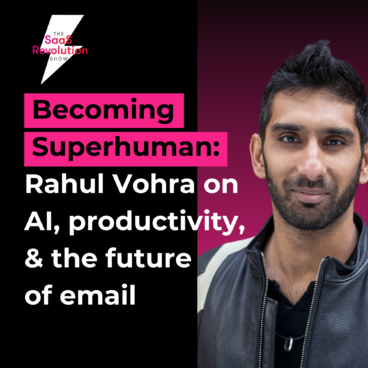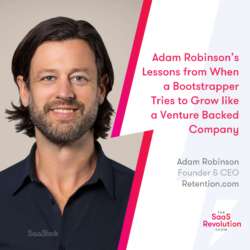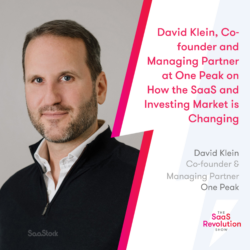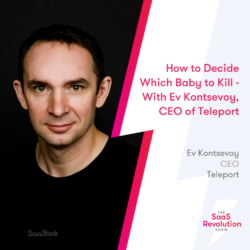In this episode of The SaaS Revolution Show, host Alex Theuma is joined by Rahul Vohra (Founder and CEO at Superhuman) to discuss how Superhuman stayed ahead of the generative AI wave, how they’re shaping the future of productivity with autonomous email agents, and why a great product that delights users—not flashy marketing—is the key to viral growth.
Rahul also opens up about the loneliness of being a CEO, his meditation practices, and the game design principles behind Superhuman’s success.
You’ll learn:
- About Rahul’s entrepreneurial journey and the story behind Superhuman.
- The three phases of AI evolution: On-demand, Always-on, and Agentic.
- How Superhuman stayed ahead of the AI curve and what others can learn from it.
- Rahul’s three-pillar go-to-market strategy for PLG success.
- How he maintains clarity, creativity, and focus as a long-term founder and CEO.
Watch (or listen) below or read on for key takeaways:
The Superhuman story: Solving a trillion hour problem
“We set out the rebuild the entire email experience from the ground up”
Before Superhuman, Rahul founded Rapportive, a Gmail plugin that was acquired by LinkedIn in 2012.
On the sale of Rapportive, he set out to solve a bigger problem–email. He realised that a global workforce of 1 billion people, spending 3 hours a day reading and writing email—equates to 1 trillion hours of lost productivity a year.
It was 2014—Gmail and Outlook were learning to cope with the volume of emails being sent and plugins like Boomerang, Mixmax, and Clearbit, were aiming to solve problems like clutter, memory, and performance slowdown.
According to Rahul, this approach made the problems with email “dramatically worse”, so he set out to rebuild it from the ground up.
Today, Superhuman helps teams from YC startups and fast growing tech companies to top tier strategy consulting firms save four hours or more each week on email.
An AI-first mindset from the start
Despite being an 11 year-old company, Superhuman has stayed ahead of the curve when it comes to AI.
Rahul identified a couple of reasons why this worked:
The vision was always there: Referring to his original pitch decks, the vision for the product always included AI features from autocomplete to email writing, and now the inclusion of context and nuance.
“We always wanted to build these things. So as you can imagine, when it became possible, we jumped on the bandwagon very quickly.”
The text-based foundation of email: Some of Superhuman’s clients write novels worth of emails each year, this is a huge amount of data that can be used to train AI models (that are already strong on text-based mediums).
By being intentional in their approach, Superhuman had a unique advantage when the AI wave arrived and it has continued to evolve ever since.
The three phases of AI evolution
Rahul looks at Superhuman’s AI evolution in three distinct phases:
- On-demand
- Always-on
- Agentic
On-demand
On-demand AI features are the ones you need to remember to use. As such, they’re an easy place to start because they only run when they’re used and don’t require huge amounts of infrastructure:
“An example from Superhuman is Write with AI. You just jot down a few words and we’ll turn them into a fully written email.”
It’s similar to the way you can with Gemini or ChatGPT but Superhuman matches the tone to emails you’ve already sent. This increases the amount of people actively using the feature:
“Our average user uses Write with AI 37 times per week, which is so much more than we thought they would. And it was a sign for us that we were on to the right thing.”
Always-on
These are features that you don’t have to remember to use. Examples from Superhuman include Auto Summarize and Instant Reply. While powerful, they require more heavy-lifting to implement:
“Always-on features are harder to build because the user isn’t directly engaging with them. They require a pretty big build out of infrastructure and they cost real money to run.”
Instant Reply and Auto Summarize have already processed many billions of emails and have been the gateway to phase three of Superhuman’s AI evolution
Agentic
Agentic refers to AI agents that replace entire workflows or parts of them. At Superhuman, it’s agentic release marks its biggest evolution yet:
“If your email needs a response then Superhuman will set a reminder. When the reminder comes back, Superhuman will write the follow-up. It’s a little mini agent, and it works automatically so you don’t have to.”
The result is a 20% increase in email efficiency.
Looking ahead, Rahul imagines a Superhuman with even more powerful agentic features, including agents that can triage, schedule, write, and send emails on your behalf.
“That kind of an agent will free us all up to be more creative, strategic, and impactful.”
The three pillars of Superhuman’s GTM strategy
When taking this product to market, Superhuman leads with a PLG motion that’s centred around three pillars:
- Virality: A branded signature, referral programme, and invite your team feature creates advocates and word of mouth buzz.
- Thought leadership: Rahul has established himself as an authority on game design and how to optimise your way to product-market fit (PMF).
- PR: The team has found ways to authentically put Superhuman into regular news cycles.
Staying resilient as a long term Founder and CEO
Being a founder involves managing ambiguity, fatigue, and pressure. Rahul spoke candidly about the emotional side of the job — and how he’s learned to navigate it.
“It’s one of the loneliest jobs in the world, and it gets lonelier as you go.”
His answer? Structure, support, and self-care. Rahul practices transcendental meditation daily and swears by weekly acupuncture, even though he describes himself as a natural sceptic.
Hear more from Rahul at SaaStock USA
Rahul is joining our stellar lineup of SaaStock USA Founderpath Center Stage speakers including Alina Vandenberghe (Chilipiper), Savneet Singh (PAR Technologies), and Neha Sampat (Contentstack).
In an interview, Rahul will cover how to translate AI products into a new era of growth, including how to craft a product people love, outmaneuver competitors, and drive unstoppable momentum for your business.
It’s not too late to join him.
If you’re serious about scaling your SaaS in 2025, you need to be there.






